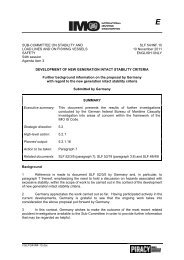Examination of the intact stability and the seakeeping behaviour
Examination of the intact stability and the seakeeping behaviour
Examination of the intact stability and the seakeeping behaviour
You also want an ePaper? Increase the reach of your titles
YUMPU automatically turns print PDFs into web optimized ePapers that Google loves.
5.3 Recommendations<br />
accelerations seems not to be a pure <strong>stability</strong> problem. Ra<strong>the</strong>r high accelerations occur for a<br />
wide scope <strong>of</strong> examined GM solid values (see gure 5.1).<br />
Regarding <strong>the</strong> occurring maximum transversal accelerations, a comparison with an usual value<br />
for <strong>the</strong> dimensioning <strong>of</strong> <strong>the</strong> container lashing equipment is interesting, since a reference value<br />
for <strong>the</strong> maximum transversal accelerations acting on humans on <strong>the</strong> bridge does not exist. For<br />
example according to <strong>the</strong> DNV rules [12], <strong>the</strong> transversal dynamic acceleration taking eect on<br />
container lashings on deck, shall be taken not smaller than ∼ 0, 5 g. The calculated accelerations<br />
on <strong>the</strong> bridge partly exceed <strong>the</strong> triple <strong>of</strong> that value. In <strong>the</strong> same time <strong>the</strong> normalized mean value<br />
<strong>of</strong> <strong>the</strong> occurring acceleration amplitudes mostly exceeds a value <strong>of</strong> ∼ 0, 5 g (refer to <strong>the</strong> respective<br />
histograms in chapter 4). Such high transversal accelerations are considered being denitely not<br />
acceptable.<br />
5.3 Recommendations<br />
The simulation results show, that <strong>the</strong> ballast arrival loading condition <strong>of</strong> container vessels is<br />
not a safe seagoing condition. The risk <strong>of</strong> encountering excessive rolling angles <strong>and</strong> very high<br />
transversal accelerations on <strong>the</strong> bridge in heavy sea is increased signicantly. Based on <strong>the</strong><br />
simulation results, <strong>the</strong> following approaches to reduce <strong>the</strong> risk <strong>of</strong> accidents can be exemplied.<br />
5.3.1 Stability<br />
Concerning <strong>the</strong> <strong>stability</strong> <strong>of</strong> <strong>the</strong> vessels, no universally valid GM value, which reduces <strong>the</strong> risk <strong>of</strong><br />
accidents, can be derived from <strong>the</strong> analysis. The <strong>seakeeping</strong> behavior <strong>of</strong> a ship apparently has<br />
a lot <strong>of</strong> important additional inuence factors. For instance two <strong>of</strong> <strong>the</strong> factors which have to<br />
be considered, are <strong>the</strong> ship's trim <strong>and</strong> <strong>the</strong> hull form. Altoge<strong>the</strong>r <strong>the</strong> factors can form a critical<br />
ship situation consisting <strong>of</strong> <strong>the</strong> ship's <strong>stability</strong>, <strong>the</strong> ship's trim, <strong>the</strong> ship's hull form <strong>and</strong> so on.<br />
To identify such critical situations for each loading condition, <strong>seakeeping</strong> calculations have to<br />
be done with adequate methods for each vessel individually. A general prediction <strong>of</strong> a critical<br />
situations is not possible until now. For three <strong>of</strong> <strong>the</strong> vessels in ballast arrival loading condition,<br />
<strong>the</strong> most critical situation is determined in chapter 6.1.<br />
5.3.2 Roll damping<br />
The enlarging <strong>of</strong> <strong>the</strong> roll damping, no matter how <strong>the</strong> damping is done, reduces <strong>the</strong> roll motions<br />
<strong>and</strong> transversal accelerations on <strong>the</strong> bridge. There are dierent ways to increase <strong>the</strong> roll damping<br />
<strong>of</strong> a ship. According to Abdel-Maksoud [11] <strong>the</strong> following possibilities t for this purpose:<br />
ˆ Enlarge <strong>the</strong> bilge keel area → roll damping by ow separation at <strong>the</strong> bilge keels<br />
ˆ Increase <strong>the</strong> ship's speed at low speeds → roll damping by shear stress on <strong>the</strong> hull, angular<br />
incoming ow on <strong>the</strong> rudder <strong>and</strong> immersed transom<br />
ˆ Integrate a roll damping tank → roll damping by e.g. a sloshing uid<br />
For a vessel already in service, <strong>the</strong> bilge keels could be modied easily. Though such a modication<br />
would not have a deciding inuence on <strong>the</strong> transversal accelerations. In appendix B.1 a<br />
graph can be found, where <strong>the</strong> bilge keel area is changed for Vessel No. 13, being <strong>the</strong> vessel<br />
with <strong>the</strong> highest occurring transversal acceleration value during <strong>the</strong> examination. In <strong>the</strong> graph<br />
<strong>the</strong> vessel in ballast arrival condition encounters <strong>the</strong> seaway <strong>of</strong> accident situation 2. it follows,<br />
that <strong>the</strong> enlarging <strong>of</strong> <strong>the</strong> bilge keel area by 50 %, just provides a reduction <strong>of</strong> <strong>the</strong> transversal<br />
accelerations <strong>of</strong> about 10 %. A general advantage <strong>of</strong> bilge keel is, that <strong>the</strong>y also function with<br />
zero speed.<br />
45

















